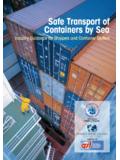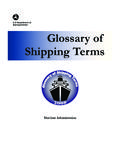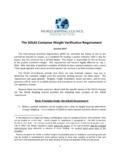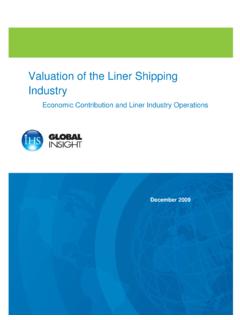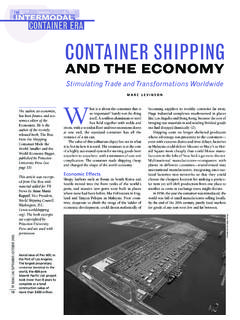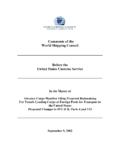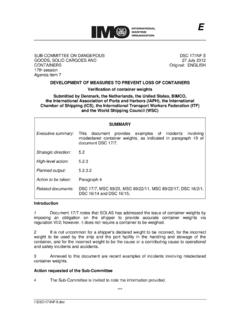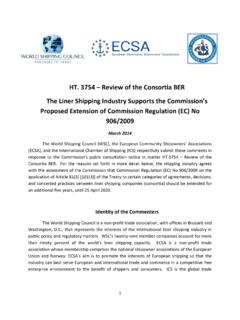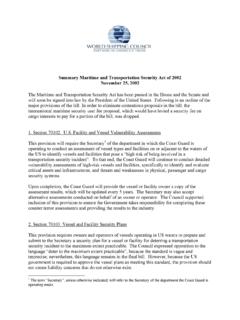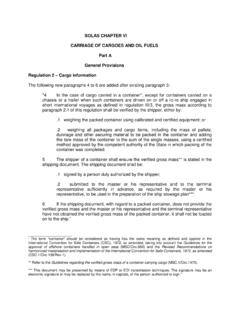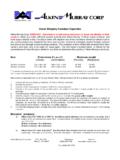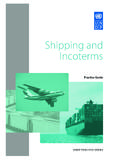Transcription of Container Supply Review - World Shipping Council
1 World Shipping Council Container Supply Review Page 1 of 11 May 2011 Container Supply Review May 2011 Today, the number of ocean Shipping containers in use in the global fleet of Container equipment is roughly million units or million The issue of sufficient Container equipment availability arises in various contexts, but there are few overall analyses of what factors are most relevant to whether Supply is constrained or ample. This World Shipping Council (WSC) paper seeks to provide a summary of the factors that influence the size and use of the global Container equipment fleet, and the current status of the aggregate Supply compared to demand. This paper seeks to address the question from a global Container Supply perspective. It does not seek to address specific regional or local Container imbalances, which may result where, for example, exports in a particular region may face a Container shortage because there are relatively few containerized imports that come to that area, and thus empty containers must be repositioned on the basis of a sufficient forecasted certainty and at a price that justifies the repositioning of the equipment to such an area.
2 This paper concludes that equipment Supply will be tight during the 2011 peak Shipping season, and that proper planning and forecasting by shippers and carriers will be important to manage through times of constrained equipment Supply . BACKGROUND The global recession of 2009 was felt deeply in the Container manufacturing sector, which had seen demand for new containers average in excess of 3 million TEU a year for the previous five years. In 2009, however, World Container production of new boxes was just 450,000 TEU, which included orders held over from This resulted in a decline in the total global Container fleet of percent, after years of continuous expansion. The demand for existing containers was also weak in 2009 when global Container cargo volume declined for the first time in history. This meant that at the end of 2009, despite the lack of new Container production, millions of empty containers were idle and available for use.
3 Carriers therefore, did not anticipate that the global fleet would need to be supplemented by new containers until the second half of 2010, when the normal seasonal cargo demand surge usually 1 A TEU is a twenty foot equivalent unit. TEU figures are calculated in terms of Container length. 20ft= ; 24ft= ; 28ft= ; 30ft= ; 40ft= ; 43ft= ; 45ft= ; 48ft= ; 53ft= 2 Containerisation International Market Analysis: Container Leasing Market 2010 World Shipping Council Container Supply Review Page 2 of 11 May 2011 occurs. As a result, in April 2010, Containerisation International projected a full year output of new boxes at million TEU, most of which would be delivered late in the year. Instead, contrary to forecasts, cargo demand surged early in the year, utilizing the surplus in the existing Container fleet. This unforecasted demand was exacerbated by the simultaneous conversion of more liner services to slow-steaming in order to reduce fuel costs, which required the use of more containers.
4 Carriers and leasing companies turned to Container manufacturers for new production; leasing companies purchased about 60 percent of the new production. It took some time for factories to increase their production capacity to meet the demand, but by the end of 2010, it is estimated that approximately million TEU were produced. The shortage of containers in 2010 caught carriers off-guard and forced them to take a number of aggressive and often costly steps to improve the availability and utilization of the existing fleet. These included: evacuating empty containers from surplus regions by deploying extra vessels just to transport the empties; reducing the length of time that empty containers remained idle; and delaying disposal of older containers. Container factory production has been restored in 2011, yet several sources have stated that Container Supply may be insufficient to meet demand in 2011.
5 This paper attempts to Review the question of adequate Container Supply in more detail. ANALYTICAL APPROACH A number of sources provide information about either the global Container fleet or the global cargo demand that will utilize those containers. The more difficult and relevant analysis is whether the expected Container fleet size is sufficient to handle the expected cargo demand. This is in large part because a number of market forces affect the availability of containers, and their impacts are difficult to quantify and predict. Therefore, we sought to evaluate each of those factors independently utilizing multiple sources, including discussions with senior equipment experts at WSC member companies and industry analysts. The results follow and a list of sources used can be found at the end of the paper. EARLY INDICATORS OF Container Supply Industry experts and analysts who monitor Container Supply look at projections in comparison to historical patterns for a number of metrics, as an early indicator of whether the global Container Supply will be sufficient.
6 Four common metrics are: new Container production; Container versus vessel slot ratio (known as the Box to Slot Ratio ); rate and volume of the scrapping of old containers (Scrapping Rate); and, the age of the carrier-owned fleet. Additionally, we felt it would be meaningful to look at the ratio between the actual cargo volume moved each year and the size of the Container fleet for that year. That relationship is calculated and discussed under Container Traffic to Container Fleet Ratio. World Shipping Council Container Supply Review Page 3 of 11 May 2011 New Container Production As evidenced by the table from Containerisation International below, Container production averaged just over 3 million TEU per year for the five-year period preceding the recession year of The combined production of 2009 and 2010, however, equated to just less than 3 million TEU ( million)4 . As a result, at the start of 2011, the global Container fleet had approximately 3 million fewer containers compared to levels to which the industry had become accustomed.
7 Current production estimates for 2011 range from 3 million to TEU. This is consistent with the historical annual production, but not sufficient to make up for the production loss 3 CIMC and Singamas are the two largest Container manufacturers. Alphaliner has estimated that these two manufactures account for approximately 60-70 percent of the market. 4 At the time of the CI table issuance (September 2010), total output for 2010 was projected at 2 million TEU. Current estimate for 2010 final output is million TEU. World Shipping Council Container Supply Review Page 4 of 11 May 2011 of 2009 and 2010, when manufacturers had to dismiss workers and shut-down production lines. These are steps the Container manufacturers presumably do not want to repeat. Based on the current projections for 2011, manufacturers are expected to operate at about 60-65 percent of their total maximum production capacity of to million TEU.
8 Output seems to be on-track to deliver the projected million TEU with a Q1 2011 estimated output at 900,000 TEU. It is probable that the manufacturers could produce an incremental 500,000 to 1 million TEU at current production-line and staffing levels if the orders are there. However, it is believed that an annual output of more than million TEU would not be possible without increasing production-lines and staffing. Prices are currently at an all-time high, reportedly exceeding $3,000 per When demand for new containers is strong, as it is in 2011, prices are likely to remain high. These high prices in turn can obviously restrain carriers decisions to order more equipment if cargo volume forecasts cannot ensure full year-round utilization of that equipment. Additionally, carriers capital budgets for 2011 were generally fixed before the start of the year, thus constraining their ability to further increase their purchases of more containers beyond budgeted quantities.
9 It seems likely that Container manufacturers will capitalize on the strong demand and produce no more than the maximum level that can be produced with existing production lines and staffing. This is estimated to be 4 to million TEU, or million TEU above current order levels, and any incremental volume will probably be produced only with firm advance orders. Some additional production capacity is expected to be in added in 2012. In the Singamas Annual Report 2010, the Chairman s Statement reports on the acquisition of land in Qidong, near Shanghai, where the company plans to build two new factories, which are expected to be operational in Box-to-Slot Ratio A common benchmark for indicating whether Container Supply is likely to be sufficient to handle cargo volume is to look at a comparison of the Container box inventory to the Container vessel capacity, as Alphaliner did in March 2011.
10 The Alphaliner Review , entitled Container Shortage to Hit Shippers, noted that the box-inventory-to-vessel capacity ratio will drop to by the end of this year from in 2010. This is the lowest ratio on record. It lies way below the boxes per slot of 2000. 7 5 Container Production and Average Prices 2000-2010, Alphaliner Weekly Newsletter Volume 2010, Issue 25, indicates price per TEU was approximately $1,500 in 2000, $2,250 in 2008 and climbing toward $3,000 at mid-year 2010. 6 Singamas Annual Report, 2010. 7 Alphaliner Weekly Newsletter, Volume 2011 Issue 10, to , p. 1. World Shipping Council Container Supply Review Page 5 of 11 May 2011 This trend does support the view that there may be a shortage of Container Supply ; however, this ratio is not the only indicator, or even the most definitive indicator, of whether sufficient Container Supply will exist.
